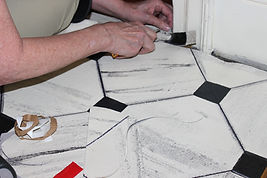Formal Entryway
The formal entryway of Sandusky has been restored to its look of the mid-nineteenth century. Typically, the entry hall was meant as a formal and elegant area where visitors were received. Below, you can read about some of the restoration and how certain colors, patterns, and items were chosen for the entryway.
The first major change in the formal parlor was to have the walls restored and to have reproduction wallpaper hung in the space. The paper used in the entryway is a reproduction French faux marble paper, custom produced for Sandusky by Waterhouse Wallcoverings in New Jersey. It is being installed by Bud Williamson of Richmond, Virginia, one of the leading paper hangers in the Commonwealth. Bud is pictured to the left preparing a sheet of the paper to be hung.

Entry halls in the nineteenth century were designed to provide first impressions to visitors. Common were papers with busy designs that helped hide scrapes or marks. They often used designs with marble, granite, block, or brick patterns. This paper recalls the Greek Classical design elements so often incorporated into the architecture and decorative arts of the nineteenth century.


Before the wallpaper could be hung, a lengthy paint analysis was performed on the walls and doors of Sandusky. Ultimately, the paint chosen was done so through the analysis of paint fragments left on the walls. These fragments were found under many layers of paint, wallpaper, and other wall treatments. The paint color seen to the left is an as-accurate-as-possible representation of the paint color that was present on the walls of the Sandusky entryway in the 1840s.
A period style floorcloth was the next major step in restoring the entryway. Floorcloths, or oil cloths, were a common choice of floor covering during the mid-1800s and were used in entryways as a way to mask the dirt, debris, and scuffs that a high traffic area would receive in a home. Historically, floorcloths were made by stretching canvas on a loom and painting first the front and then the back with a thick paint. Once dry the canvas would be decorated, often in a similar fashion to the floorcloth at Sandusky, with paint heavily laden with linseed oil. The use of linseed oil in the decorative paint is where the common name oilcloth comes from.



The floorcloth now in the Sandusky entryway was designed by Jennifer Frantz of Americana Floorcloths at her studio in Ohio. The floorcloth was then transported from her workshop to Sandusky and installed as a wall-to-wall piece. Above and left, the floorcloth is being installed and fitted around the transition molding into the family parlor by Jennifer Frantz.
A tall case clock was one of the final touches of the Sandusky entryway. Used as a way to tell the time, date, and phase of the moon, a clock was one of the most important assets of a home during the nineteenth century.
Donated by Buzzards Roost Antiques of Lynchburg Virginia, the tall case clock at Sandusky is a working, period accurate piece. Pictured to the left and right Christopher Hunley of Buzzards Roost assembles and sets the case clock during Christmas Open House 2016.


Pictured at left is the finished entryway. Completed in January of 2017, the entryway features reproduction wallpaper, floorcloth, and mirror, a period tall case clock, and painted moldings and doors that are representative of what would have been seen in the home in the mid nineteenth century.
Each addition to the entryway was researched and thoughtfully chosen with the realistic nineteenth century look of Sandusky in mind.


